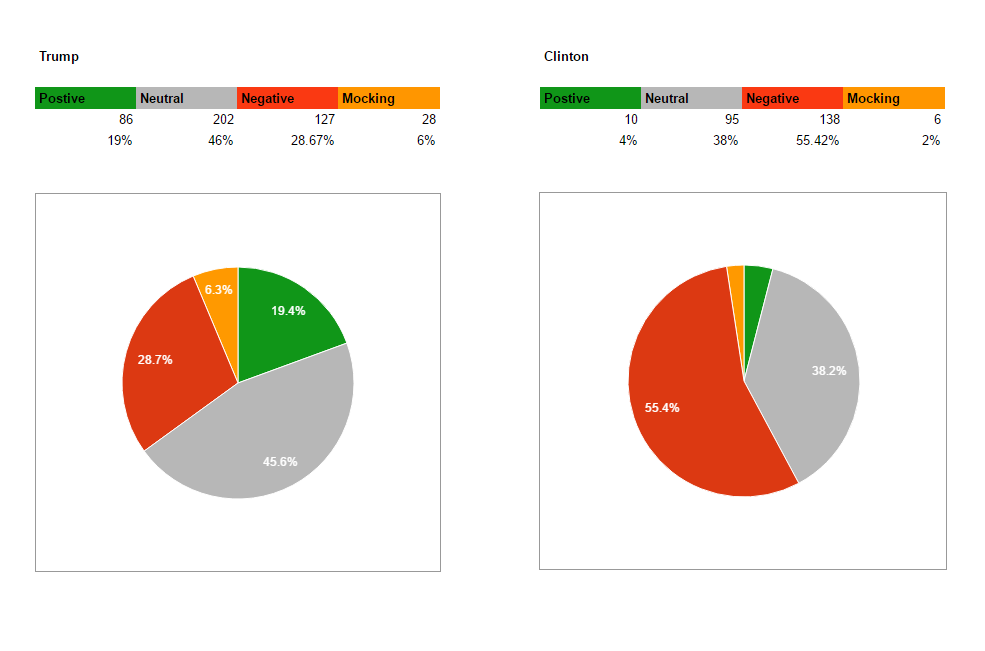While Donald Trump has spewed forth countless paeans to Vladimir Putin over the last decade, the Russian President himself has been rather more muted, evincing little public enthusiasm for the man who could win the election on Tuesday. Nor have Russian officials swayed from the official line of diplomatic neutrality.
However the Kremlin has indeed done its best to put wind in the Trump campaigns sails by means of its most widely received mouthpieces.
Russian state-owned, English-language media outlets can be shown to exhibit a clear bias against Hillary Clinton’s campaign.
We analyzed every tweet mentioning the words “Trump,” Hillary” or Clinton” posted by four accounts – @RT_com, @RT_america, @SputnikInt and @SputnikNewsUS – between September 25 and October 25 this year.
692 tweets were analyzed in total. 443 of them mentioning Trump, 249 Clinton. While Sputnik (an online news agency formed out of remnants of Voice of Russia radio and RIA Novosti’s English-language service) gave roughly equal airtime to both candidates (114 mentioning Trump against 110 on Clinton), RT dedicated far more time to reporting on Trump. Over the one-month period, RT and RT America mentioned Trump 329 times but named Clinton 139 times.
The tweets were divided into four categories:
Positive – which portrayed the candidate in a positive light or indicated enthusiasm for their statements.
Neutral – news items about the candidates that exhibited no clear bias.
Negative – tweets highlighting criticism of the candidates or negatively portraying their actions.
Mocking – light-hearted tweets which mock the candidates’ personalities or behaviour, but do not amount to any real criticism.
The disparity between the Twitter coverage for each candidate was striking. Across all four Twitter accounts, 28.7% of the tweets mentioning Trump were negative. By contrast, 55.4% of those mention Hillary Clinton were negative.

19.4% of the Trump tweets were positive compared to only 4% of those related to Clinton.
In addition, neutral coverage vastly outweighed either positive or negative with regards to Trump with 46% of the tweets falling into that category. On the other hand, only 38.2% of Clinton coverage was neutral.
Coverage of Trump was roughly equivalent between the RT and Sputnik accounts, while Sputnik was somewhat more negative regarding Clinton than RT (48% negative tweets for RT compared with 65% for Sputnik). 2% of Sputnik’s tweets about Clinton were positive, while RT had 5%.
The bias here is more anti-Clinton than pro-Trump, but the difference in the treatment of the two candidates is dramatically clear.
Of course, the extent to which RT and Sputnik can influence the American election is debatable.
In March this year, RT claimed to have more than eight million weekly viewers in the United States, with far higher viewing figures for their video content on YouTube.
But as Katie Zavadski and The Interpreter’s editor-in-chief, Michael Weiss, reported at The Daily Beast last year, leaked internal documents indicate that RT had been vastly exaggerating their audience figures, both for television viewers and web content. Furthermore, “soft news” items – covering humorous or bizarre stories, made up the bulk of their online traffic. Similarly, it is uncertain how many of the Twitter accounts that re-tweet or interact with RT or Sputnik’s posts are bots.
But, while the efficacy of the Kremlin’s propaganda push in the US elections is uncertain, it does give a clear indicator of the Russian government’s preference in the race. If not necessarily pro-Trump, they are certainly anti-Clinton.